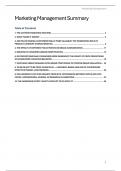Marketing Management
Marketing Management Summary
Table of Contents
1: THE ULTIMATE MARKETING MACHINE ........................................................................................ 2
2: WHAT MAKES IT GREEN? ........................................................................................................... 5
3: ARE MULTICHANNEL CUSTOMERS REALLY MORE VALUABLE? THE MODERATING ROLE OF
PRODUCT CATEGORY CHARACTERISTICS. .................................................................................... 8
4: THE IMPACT OF DIFFERENT TOUCHPOINTS ON BRAND CONSIDERATION .................................. 11
5: DRIVERS OF CONSUMER–BRAND IDENTIFICATION................................................................... 14
6: DO PROMOTIONS MAKE CONSUMERS MORE GENEROUS? THE IMPACT OF PRICE PROMOTIONS
ON CONSUMERS’ DONATION BEHAVIOR ..................................................................................... 18
7: MATCHING GREEN MESSAGES WITH BRAND POSITIONING TO IMPROVE BRAND EVALUATION ... 24
8: TO BE OR NOT TO BE PRICE CONSCIOUS — A SEGMENT-BASED ANALYSIS OF COMPROMISE
EFFECTS IN MARKET-LIKE FRAMINGS .......................................................................................... 29
9: WILLINGNESS TO PAY FOR ORGANIC PRODUCTS: DIFFERENCES BETWEEN VIRTUE AND VICE
FOODS. INTERNATIONAL JOURNAL OF RESEARCH IN MARKETING ............................................... 33
10: THE HANDMADE EFFECT: WHAT'S LOVE GOT TO DO WITH IT?.................................................. 38
1
, Marketing Management
1: The Ultimate Marketing Machine
De Swaan Arons, M., van den Driest, F., & Weed, K. (2014). The Ultimate Marketing
Machine. Harvard Business Review, 4, 55-63.
Paper motivation
• In the past decade, what marketers do to engage customers has changed almost
beyond recognition. Tools and strategies that were cutting-edge just a few years
ago are fast becoming obsolete, and new approaches are appearing every day.
Research question
• Marketing leaders instead must ask, “What values and goals guide our brand
strategy, what capabilities drive marketing excellence, and what structures and
ways of working will support them?” Structure must follow strategy—not the
other way around.
Method
• To understand what separates the strategies and structures of superior
marketing organizations from the rest, EZectiveBrands (now Millward Brown
Vermeer) initiated Marketing2020, which is the most comprehensive marketing
leadership study ever undertaken.
Results
• Big data, deep insights.
o Marketers today are awash in customer data, and most are
finding narrow ways to use that information to improve the
targeting of messages.
o The Nike+ suite of personal fitness products and services
combines a deep understanding of what makes athletes tick
with troves of data.
2
, Marketing Management
• Purposeful positioning.
o Top brands excel at delivering all three manifestations of
brand purpose: functional benefits (Starbucks),emotional
benefits, and societal benefits.
o In addition to engaging customers and inspiring employees,
a powerful and clear brand purpose improves alignment
throughout the organization and ensures consistent
messaging across touchpoints (Dulux paint: let’s color).
• Total experience
o Companies are increasingly enhancing the value of their products by
creating customer experiences: emphasizing depth (personalisation) and
breath (touchpoints) of the customer relationship (Netflix).
• Organizing for growth
o The leaders of high-performing companies connect marketing to the
business strategy and to the rest of the organization; inspire their
organizations by engaging all levels with the brand purpose; focus their
people on a few key priorities; organize agile, cross-functional teams; and
build the internal capabilities needed for success.
• Connecting
o High-performing marketing leaders don’t just align their
department’s activities with company strategy; they actively
engage in creating it.
o Another way companies foster connections is by putting
marketing and other functions under a single leader (Visa,
Unilever).
• Inspiring
o High-performing marketers are more likely to engage
customers and employees with their brand purpose—and
that employees in those organizations are more likely to
express pride in the brand (Dulux, Unilever, Nike, Google).
• Focusing
o “Local marketing understands the global strategy” and
“Global marketing understands the local marketing reality.”
o Winning companies were more likely to measure brands’
success against key performance indicators such as revenue
growth and profit and to tie incentives at the local level
directly to those KPIs.
• Organising for agility
o Organizational structure, roles, and processes are among the toughest
leadership challenges—and that the need for clarity about them is
consistently underestimated or even ignored.
3
, Marketing Management
o Marketing organizations must leverage global scale but also be nimble,
able to plan and execute in a matter of weeks or a few months—and,
increasingly, instantaneously (Oreo).
o New Marketing roles: Companies are removing middle, often regional,
layers and creating specialized “centers of excellence” that guide strategy
and share best practices while drawing on needed resources.
o The networked organization: Orchestrators brief the teams, ensure that
they have the capabilities and resources they need, and oversee
performance tracking. Google, Nike, Red Bull, and Amazon all embrace
this philosophy.
• Building capabilities
o The best marketing organizations, including Coca-Cola, Unilever, and
Shiseido, have invested in dedicated internal marketing academies to
create a single marketing language and way of doing marketing.
o Underperforming marketers, on the other hand, underinvest in training.
4





